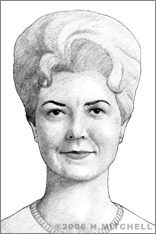

 | | 
|
|---|
This month's topic is about Bette Nesmith Graham, a secretary and single mother raising a son on her own. While she was not a chemist, she was the inventor of Liquid Paper correction fluid, one of the most simple, yet work-saving inventions in all of office-supply history.
---
 As electric typewriters came into widespread use after World War II, Bette Nesmith Graham and countless other secretaries let out a collective groan. The new machines did make typing easier, but their carbon-film ribbons made it impossible to correct mistakes neatly with a pencil eraser. As a result of this predicament, Graham ended up inventing one of the most widely used office products of the 20th century.
As electric typewriters came into widespread use after World War II, Bette Nesmith Graham and countless other secretaries let out a collective groan. The new machines did make typing easier, but their carbon-film ribbons made it impossible to correct mistakes neatly with a pencil eraser. As a result of this predicament, Graham ended up inventing one of the most widely used office products of the 20th century.
Born Bette Clair McMurray in 1924 in Dallas, Texas, she dropped out of high school at the age of seventeen and married Warren Nesmith at the age of 19. However, shortly after World War II ended, she found herself divorced with a small child to support. She went to secretarial school and worked as a secretary while earning her GED in night school.
By 1951, she had worked her way up to the position of executive secretary for W.W. Overton, the Chairman of the Board of the Texas Bank and Trust. It was at this time that she and her colleagues at the bank began experiencing trouble with the new IBM electric typewriters. Tired of having to retype entire pages because of one small error, she determined to find a more efficient alternative.
The impetus for her breakthrough came as she observed painters decorating the bank windows for the holidays. Rather than remove their mistakes entirely, the painters simply covered any imperfections with an additional layer. She decided to mimic their technique by using a white, water-based tempera paint to cover her typing errors.
She came up with a very simple formula that she began making in batches just for her to use at work. Using her kitchen blender she mixed up some tempera water-based paint, tinting it to match her company stationery. She took it to the office with a watercolor brush and whenever she made a mistake on paper, she simply painted over it and fixed the error.
The formula worked like magic. In fact, her boss never even noticed the corrected errors in her work. It wasn't long before other secretaries at her company found out about the ingenious solution she had created and when they began asking her if they could use some of the fluid, she began making up bottles, putting labels on them that read "Mistake Out," and giving them to friends.
She soon began to realize that the product was popular enough to form the basis for a business. She started the Mistake Out Company in 1956 in her home, mixing the fluid in her kitchen. She employed her son Michael, who would later achieve fame as a member of the pop group The Monkees, and his friends to fill bottles for customers.
When she became too engrossed in her own business, her boss at the bank fired her. It was a blessing in disguise: Now she could devote all her time to the Mistake Out business.
She continued experimenting with the makeup of the substance until she achieved the perfect combination of paint and several other chemicals. The refined product was renamed "Liquid Paper®" in 1958 and, amid soaring demand, she applied for a patent and a trademark that same year.
Before long she was selling around 100 bottles of Liquid Paper per month. In 1957, a magazine called "The Office" mentioned the product and General Electric placed a large order. Soon, business was booming. In 1962, she married Robert Graham and he joined the business.
The Liquid Paper Company experienced tremendous growth over the next decade. By 1967, the company had its own corporate headquarters and automated production plant, and sales were in excess of one million units per year.
In 1975, she opened a 35,000-square-foot headquarters building for Liquid Paper in Dallas. A year later, the company's net earnings were $1.5 million and product was being sold in 31 countries around the world. Bette Nesmith Graham was innovative in establishing her company culture, encouraging employees to participate in making corporate decisions and setting up an in-plant library and child-care center. She also used a portion of her fortune to set up two foundations to help women in need, the Gihon Foundation, established in 1976; and the Bette Clair McMurray Foundation, founded in 1978. She sold the company to the Gillette Corporation for $47.5 million four years later, just six months before her death in 1980.
References:
http://inventors.about.com/od/lstartinventions/a/liquid_paper.htm
http://web.mit.edu/INVENT/iow/nesmith.html
http://www.women-inventors.com/Bette-Nesmith-Graham.asp
— Written by Cherlyn Bradley